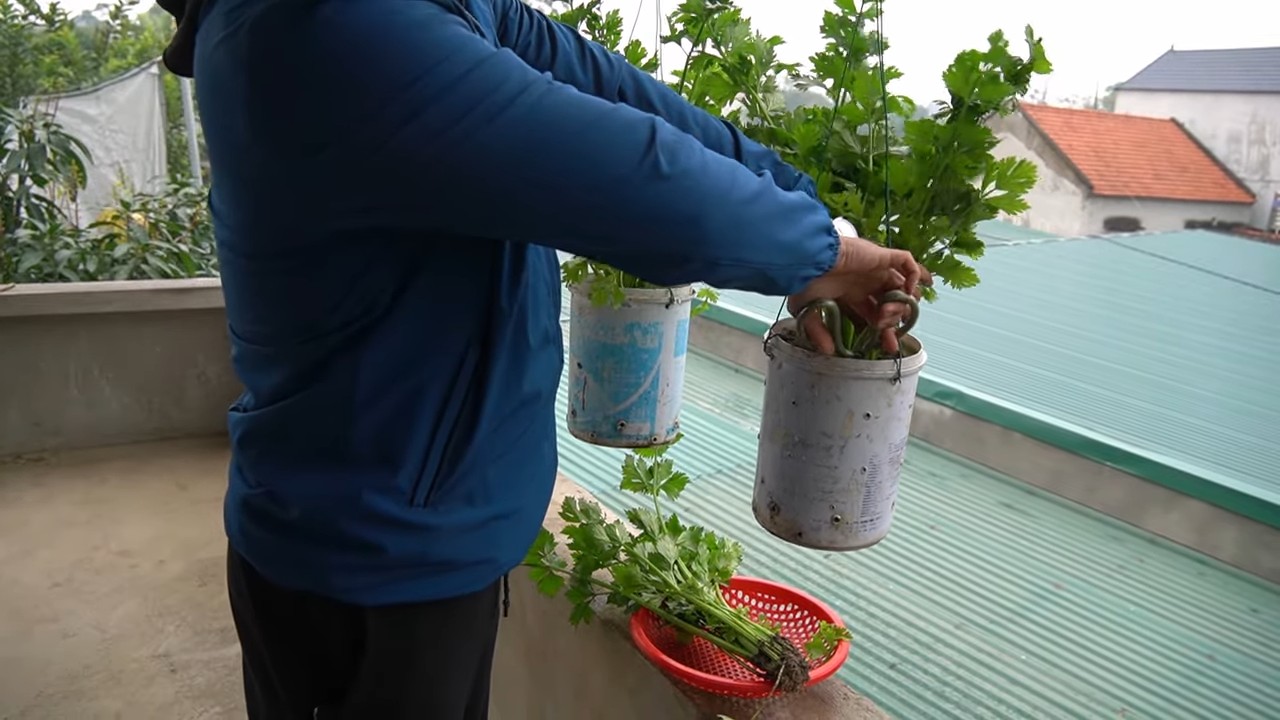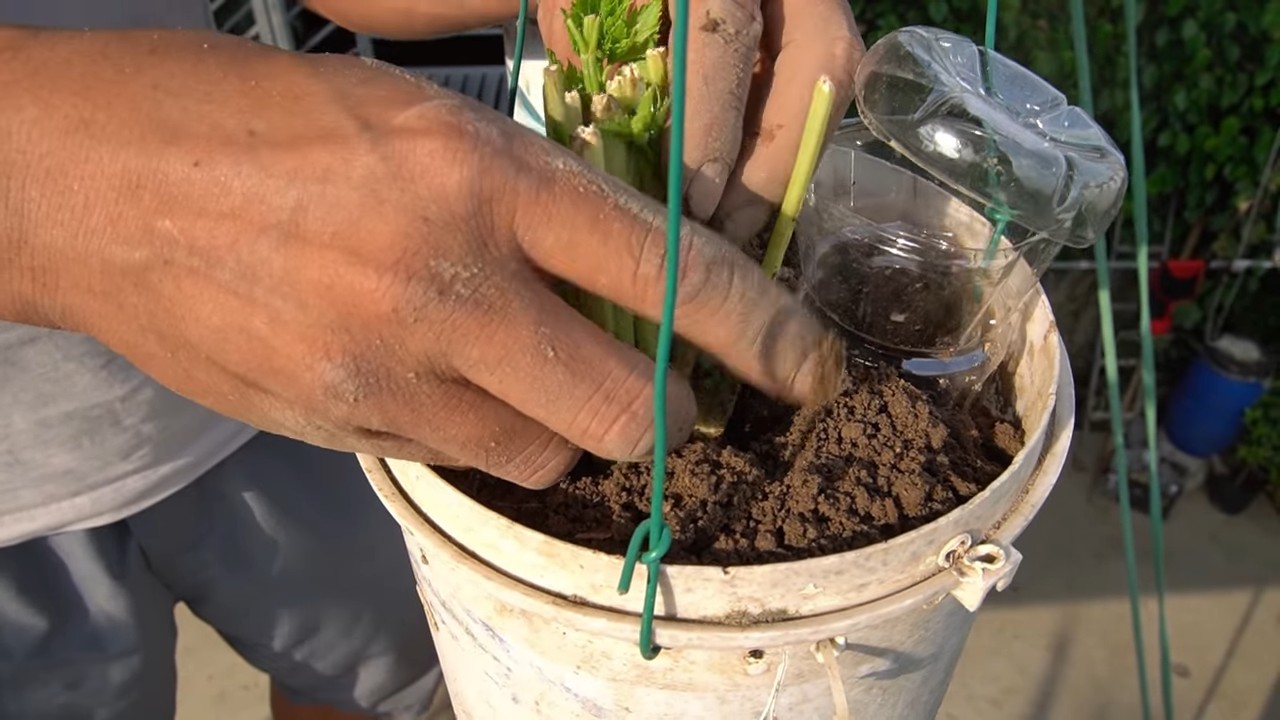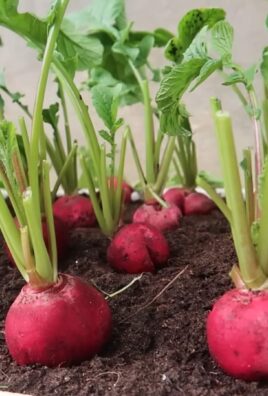Grow Celery At Home, even if you think you don’t have a green thumb! Have you ever tossed the base of a celery stalk, thinking it was just kitchen waste? Well, prepare to be amazed! This simple DIY trick will not only save you money but also bring the joy of fresh, homegrown celery right to your kitchen. For centuries, celery has been valued not only for its crisp texture and refreshing taste but also for its medicinal properties. Ancient Greeks and Romans used it for everything from flavoring food to treating ailments.
But why should *you* bother learning to grow celery at home? Think about it: no more wilted, expensive celery from the grocery store! Imagine the satisfaction of snipping off exactly what you need for your soups, salads, or even a healthy snack, knowing it’s fresh, organic, and grown with your own two hands. Plus, it’s a fantastic way to reduce food waste and connect with nature, even if you only have a small balcony or windowsill. I’m going to show you how incredibly easy it is to regrow celery from those seemingly useless scraps. Get ready to transform your kitchen scraps into a thriving celery patch – let’s get started!

Grow Your Own Celery: A Beginner’s Guide
Hey there, fellow gardening enthusiasts! Ever thought about growing your own celery? It’s surprisingly easy and rewarding, and nothing beats the fresh, crisp taste of homegrown celery. I’m going to walk you through the whole process, from starting seeds to harvesting your crunchy stalks. Let’s get started!
Choosing Your Celery Variety
First things first, let’s talk celery varieties. While you can technically grow any celery from seed, some are better suited for home gardens than others. Here are a few popular choices:
* ‘Utah Improved’: This is a classic, reliable variety known for its tall, crisp stalks and good flavor. It’s a great all-around choice for beginners.
* ‘Golden Self-Blanching’: This heirloom variety is unique because it naturally blanches (turns pale yellow) as it grows, resulting in a milder, sweeter flavor. It’s a bit more challenging to grow, but the results are worth it.
* ‘Giant Red’: If you’re looking for something a little different, try ‘Giant Red’ celery. It has beautiful reddish-purple stalks and a slightly stronger flavor.
Starting Celery Seeds (The Patient Gardener’s Route)
Celery seeds are notoriously slow to germinate, so starting them indoors is highly recommended. This gives them a head start and protects them from harsh weather.
What You’ll Need:
* Celery seeds (of course!)
* Seed starting trays or small pots
* Seed starting mix (a fine, well-draining mix is best)
* Spray bottle
* Plastic wrap or a humidity dome
* Grow lights (optional, but helpful)
Step-by-Step Instructions:
1. Sow the Seeds: Celery seeds are tiny, so sprinkle them very lightly over the surface of your seed starting mix. Don’t bury them too deep; they need light to germinate. I usually just gently press them into the soil with my finger.
2. Moisten the Soil: Use a spray bottle to thoroughly moisten the soil. You want it damp, but not soggy.
3. Create a Humid Environment: Cover the seed starting tray with plastic wrap or a humidity dome to create a humid environment. This will help the seeds germinate.
4. Provide Light and Warmth: Place the tray in a warm location (around 70-75°F or 21-24°C) with plenty of light. If you don’t have a sunny windowsill, use grow lights. I find grow lights make a huge difference in germination rates.
5. Be Patient: Celery seeds can take anywhere from 14 to 21 days (or even longer!) to germinate. Keep the soil consistently moist and be patient. Check daily and mist as needed.
6. Remove the Cover: Once the seedlings emerge, remove the plastic wrap or humidity dome.
7. Thin the Seedlings: Once the seedlings have a few true leaves (the second set of leaves), thin them out so that they are spaced about 1-2 inches apart. I know it’s hard to do, but it’s necessary for healthy growth.
8. Harden Off the Seedlings: Before transplanting the seedlings outdoors, you need to harden them off. This means gradually exposing them to outdoor conditions over a period of about a week. Start by placing them outside for an hour or two each day, gradually increasing the amount of time they spend outdoors.
Transplanting Celery Seedlings
Once your celery seedlings are about 4-6 inches tall and the danger of frost has passed, it’s time to transplant them into your garden.
What You’ll Need:
* Your hardened-off celery seedlings
* Well-draining soil rich in organic matter
* Compost or aged manure
* Trowel
* Watering can
Step-by-Step Instructions:
1. Prepare the Soil: Celery needs rich, well-draining soil. Amend your soil with compost or aged manure to improve its fertility and drainage. I usually dig in a generous amount of compost before planting.
2. Space the Seedlings: Space the seedlings about 6-10 inches apart in rows that are 18-24 inches apart. This gives them enough room to grow and mature.
3. Plant the Seedlings: Dig a small hole for each seedling and gently remove it from its container. Place the seedling in the hole, making sure the top of the root ball is level with the soil surface.
4. Water Thoroughly: Water the seedlings thoroughly after planting. This will help them settle in and establish their roots.
Caring for Your Celery Plants
Celery requires consistent moisture and regular feeding to thrive. Here’s what you need to do:
* Watering: Celery needs consistently moist soil. Water deeply and regularly, especially during hot, dry weather. I usually water my celery plants every other day, or more often if the soil feels dry to the touch.
* Fertilizing: Celery is a heavy feeder, so it needs regular fertilization. Use a balanced fertilizer every 2-3 weeks. I like to use a liquid fertilizer diluted to half strength.
* Weeding: Keep the area around your celery plants free of weeds. Weeds compete with celery for nutrients and water.
* Mulching: Mulch around your celery plants with straw or hay to help retain moisture and suppress weeds.
* Blanching (Optional): Blanching celery stalks makes them milder and sweeter. You can blanch celery by mounding soil around the stalks or wrapping them with paper or cardboard. Start blanching about 2-3 weeks before harvest.
Dealing with Pests and Diseases
Celery is relatively pest-resistant, but it can be susceptible to a few problems:
* Celery Leaf Tier: These caterpillars feed on celery leaves, causing damage. Handpick them off the plants or use an organic insecticide.
* Aphids: These tiny insects suck sap from celery leaves. Spray them off with a strong stream of water or use an insecticidal soap.
* Celery Blight: This fungal disease causes brown spots on celery leaves. Prevent celery blight by providing good air circulation and avoiding overhead watering. If you see signs of celery blight, remove the affected leaves and spray the plants with a fungicide.
Harvesting Your Celery
You can start harvesting celery when the stalks are about 6-8 inches tall.
Step-by-Step Instructions:
1. Harvest Individual Stalks: You can harvest individual stalks as needed by cutting them off at the base of the plant with a sharp knife.
2. Harvest the Entire Plant: To harvest the entire plant, cut it off at the base of the plant with a sharp knife.
3. Store Your Celery: Store your harvested celery in the refrigerator. It will keep for several weeks if stored properly. I like to wrap mine in a damp paper towel and place it in a plastic bag.
Troubleshooting Common Celery Growing Problems
Even with the best care, you might encounter a few challenges when growing celery. Here are some common problems and how to fix them:
* Celery stalks are bitter: This can be caused by a lack of water or nutrients, or by hot weather. Make sure your celery plants are getting enough water and fertilizer, and try to provide some shade during the hottest part of the day. Blanching can also help reduce bitterness.
* Celery stalks are tough: This can be caused by a lack of water or by harvesting the celery too late. Make sure your celery plants are getting enough water, and harvest them when the stalks are still tender.
* Celery plants are bolting (going to seed): This can be caused by hot weather or stress. Try to provide some shade during the hottest part of the day, and make sure your celery plants are getting enough water and nutrients.
Extra Tips for Celery Success
Here are a few extra tips to help you grow the best celery possible:
* Start with good quality seeds: Don’t skimp on seeds! Buy from a reputable source to ensure good germination rates.
* Provide consistent moisture: Celery needs consistently moist soil, so don’t let it dry out.
* Fertilize regularly: Celery is a heavy feeder, so it needs regular fertilization.
* Protect from pests and diseases: Keep an eye out for pests and diseases, and take action quickly if you see any problems.
* Be patient: Celery takes time to grow, so don’t get discouraged if it doesn’t happen overnight.
Growing your own celery is a rewarding experience. With a little patience and care, you can enjoy fresh, crisp celery from your own garden. Happy gardening!

Conclusion
So, there you have it! Growing celery at home from scraps isn’t just a fun experiment; it’s a sustainable way to reduce food waste, save money, and enjoy fresh, flavorful celery whenever you need it. Forget those limp, store-bought stalks that have traveled miles – imagine the satisfaction of snipping off crisp, vibrant celery grown right in your own kitchen.
This DIY trick is a must-try for several reasons. First, it’s incredibly easy. You don’t need a green thumb or any special equipment. If you can put a celery base in water, you can grow celery. Second, it’s a fantastic way to teach children about plant life cycles and the importance of reducing waste. It’s a hands-on learning experience that’s both educational and rewarding. Third, it provides a continuous supply of celery for your favorite recipes. From soups and salads to smoothies and snacks, fresh celery adds a delightful crunch and subtle flavor that elevates any dish.
But the benefits don’t stop there. By growing your own celery, you’re also reducing your carbon footprint. You’re eliminating the need for transportation and packaging, which contributes to environmental pollution. Plus, you have complete control over the growing process, ensuring that your celery is free from harmful pesticides and chemicals.
Looking for variations? Absolutely! Once your celery has established roots and new growth, you can transplant it into a larger pot or even your garden. Experiment with different soil types and fertilizers to see what works best for your growing conditions. You can also try growing different varieties of celery, such as Pascal celery or Chinese celery, for a wider range of flavors and textures. Consider companion planting with herbs like parsley or basil to deter pests and enhance the flavor of your celery.
Don’t be afraid to get creative and personalize your celery-growing experience. Add a decorative pot to your windowsill, create a mini-garden on your balcony, or even start a community garden with your neighbors. The possibilities are endless!
We wholeheartedly encourage you to try this simple yet rewarding DIY trick. It’s a small change that can make a big difference in your life and the environment. So, grab a celery base, a glass of water, and get ready to embark on a fun and fulfilling gardening adventure.
Once you’ve tried growing celery at home, we’d love to hear about your experience. Share your tips, tricks, and photos on social media using the hashtag #HomeGrownCelery. Let’s inspire others to embrace sustainable living and enjoy the delicious rewards of growing their own food. We are confident that you will find that growing celery at home is easier than you think!
Frequently Asked Questions (FAQ)
How long does it take to grow celery from a base?
The initial regrowth from a celery base typically takes about 1-2 weeks. You’ll start to see new leaves sprouting from the center of the base. After about 3-4 weeks, once the roots are well-established and the plant has grown significantly, you can transplant it into soil. It will take several months to grow to full size.
What kind of water should I use?
Tap water is generally fine, but letting it sit out for a few hours to allow chlorine to dissipate is beneficial. You can also use filtered water. Avoid using distilled water, as it lacks the minerals that plants need. Change the water every 1-2 days to prevent bacterial growth and keep the celery base healthy.
How much sunlight does celery need?
Celery thrives in bright, indirect sunlight. Place your celery base near a sunny window, but avoid direct sunlight, which can scorch the leaves. If you don’t have a sunny window, you can use a grow light to provide supplemental lighting. Aim for at least 6 hours of light per day.
What kind of soil should I use for transplanting?
Use a well-draining potting mix that is rich in organic matter. You can also amend your soil with compost or aged manure to improve its fertility. Celery prefers slightly acidic soil with a pH between 6.0 and 6.8.
How often should I water my celery plant?
Celery needs consistent moisture to thrive. Water your plant regularly, keeping the soil consistently moist but not waterlogged. Check the soil moisture level daily and water when the top inch of soil feels dry to the touch. Avoid overwatering, which can lead to root rot.
What are some common problems when growing celery?
Some common problems include pests like aphids and celery leaf miners, as well as diseases like celery blight and pink rot. Regularly inspect your plants for signs of pests or diseases and take appropriate action. You can use insecticidal soap or neem oil to control pests, and fungicides to treat diseases. Proper watering and good air circulation can also help prevent problems.
Can I grow celery indoors year-round?
Yes, you can grow celery indoors year-round, provided you have adequate light and moisture. Use grow lights to supplement natural light during the winter months. Maintain a consistent watering schedule and monitor your plants for pests and diseases.
How do I harvest celery?
You can harvest individual stalks as needed, or harvest the entire plant at once. To harvest individual stalks, simply cut them off at the base of the plant. To harvest the entire plant, cut it off at the soil line. Celery is typically ready to harvest when the stalks are about 6-8 inches long.
Can I eat the leaves of the celery plant?
Yes, the leaves of the celery plant are edible and have a stronger flavor than the stalks. You can use them in salads, soups, stews, or as a garnish. They are also a great addition to smoothies and juices.
How can I make my celery sweeter?
Celery can sometimes have a bitter taste, especially if it’s grown in hot weather or stressed conditions. To make your celery sweeter, try blanching it by covering the stalks with soil or paper for a few weeks before harvesting. This will block sunlight and reduce the production of bitter compounds. You can also choose sweeter varieties of celery, such as Golden Self-Blanching celery.
What if my celery doesn’t regrow?
Sometimes, the celery base may not regrow. This could be due to several factors, such as the celery being too old, the water being contaminated, or the base being damaged. Try using a fresh celery base and ensuring that the water is clean and changed regularly. If the base still doesn’t regrow after a few weeks, it may be best to start with a new one.
Is growing celery at home organic?
Growing celery at home can be organic if you use organic potting mix, organic fertilizers, and avoid using synthetic pesticides and herbicides. You have complete control over the growing process, allowing you to ensure that your celery is grown in a healthy and sustainable way.
How do I prevent celery from bolting (going to seed)?
Bolting is when a plant prematurely flowers and goes to seed, which can make the stalks tough and bitter. To prevent celery from bolting, avoid exposing it to extreme temperature fluctuations and ensure that it has consistent moisture. Also, choose bolt-resistant varieties of celery.




Leave a Comment